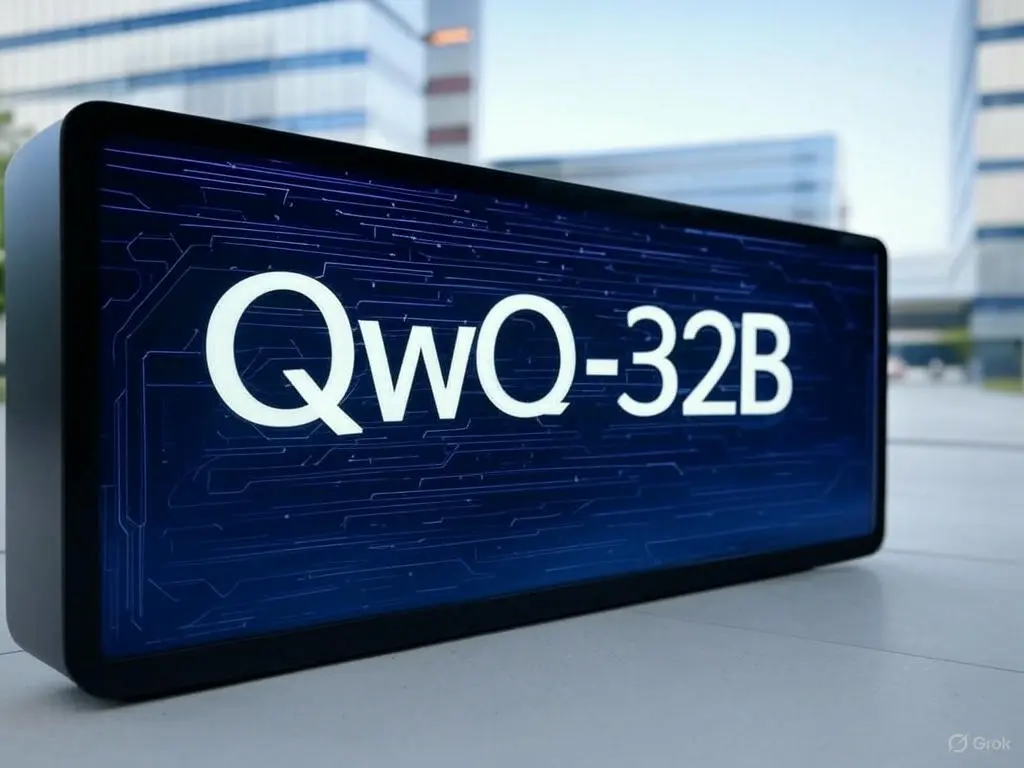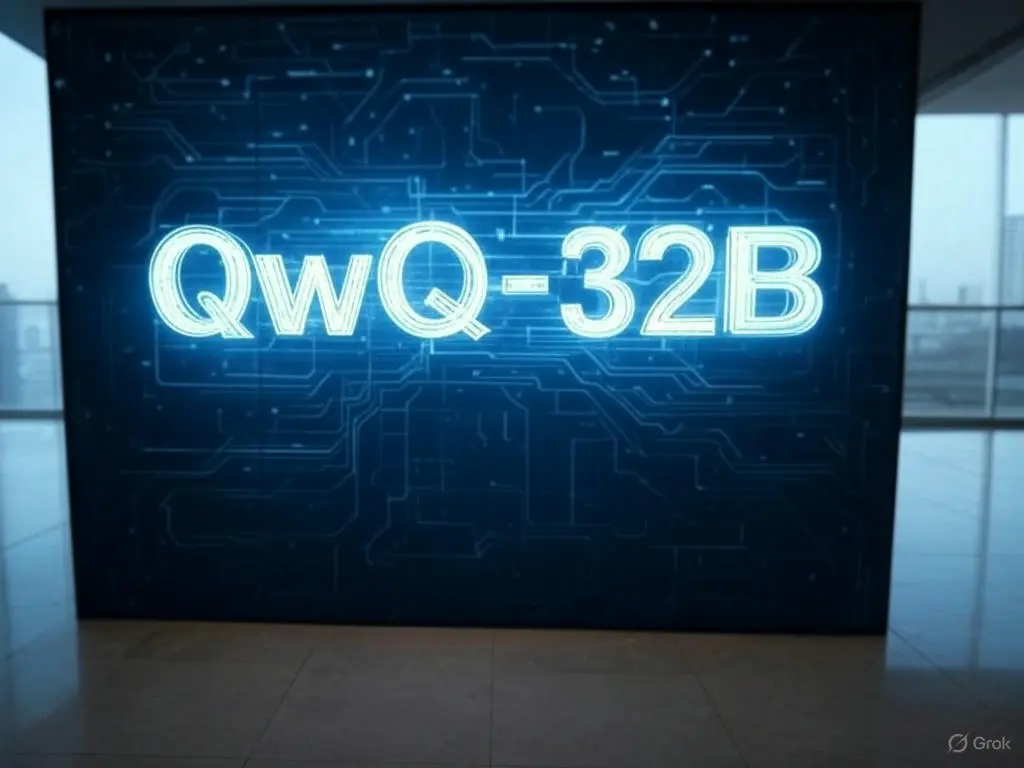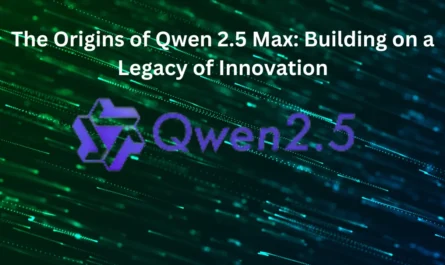Introduction: A Game-Changing Moment in AI
On March 6, 2025, the tech world turned its eyes to China as Alibaba unveiled its latest artificial intelligence marvel: the Alibabas QwQ 32B reasoning model. This isn’t just another product launch—it’s a bold statement in the escalating AI race, positioning Alibaba as a direct competitor to DeepSeek, a rising star known for its groundbreaking R1 model.
Alibaba claims that QwQ-32B matches or even surpasses R1’s abilities in key areas like mathematics, coding, and problem-solving, all while operating with a fraction of the resources—32 billion parameters compared to R1’s staggering 671 billion. The announcement sent Alibaba’s Hong Kong-listed shares soaring by 8%, signaling investor excitement and hinting at a seismic shift in the AI landscape. But what does this mean for DeepSeek’s dominance, and how might this rivalry reshape the future of AI innovation? Let’s dive into the details.

Alibaba’s Big Move: The QwQ-32B Unveiled
Alibaba’s QwQ-32B isn’t just a technical achievement; it’s a strategic play. Named as part of the Qwen family of AI models (short for “Qwen-with-Questions”), this new model is designed to tackle complex reasoning tasks with efficiency at its core.
While DeepSeek’s R1 has been celebrated for its cost-effective brilliance—trained for less than $6 million using Nvidia H800 chips—Alibaba is now raising the stakes. With only 32 billion parameters, QwQ-32B promises performance on par with R1’s 671 billion, a feat that’s turning heads in the tech community. Imagine a lightweight boxer stepping into the ring with a heavyweight and holding their own—that’s the kind of disruption Alibaba is aiming for.
The launch timing couldn’t be more telling. Coming just months after DeepSeek’s R1 shook up the global AI scene in January 2025, Alibaba’s move feels like a calculated counterpunch. Investors clearly agree: the 8% surge in Alibaba’s Hong Kong shares reflects a wave of optimism about the company’s AI ambitions.
But beyond the stock market buzz, this development is sparking bigger questions: Can Alibaba challenge DeepSeek’s cost-efficiency edge? And what does this mean for the broader AI rivalry unfolding in China?
DeepSeek’s R1: The Benchmark to Beat

To understand the stakes, we need to look at DeepSeek’s R1. Launched earlier this year, R1 stunned the world with its ability to rival top Western models like OpenAI’s offerings, all while keeping costs remarkably low. Built by a Chinese startup with ties to High-Flyer Capital Management, R1 became a symbol of China’s growing AI prowess.
Its 671 billion parameters (with 37 billion active during inference) delivered impressive results in mathematics, coding, and general reasoning, proving that innovation doesn’t always require billion-dollar budgets. For months, DeepSeek held the spotlight as the poster child of efficient AI, inspiring both awe and envy.
But R1’s success also painted a target on its back. Competitors like Alibaba saw an opportunity to not just match it but to redefine the game. Enter QwQ-32B, which Alibaba touts as a leaner, meaner alternative. With claims of “exceptional performance” that “almost entirely surpasses” OpenAI’s o1-mini and rivals R1, Alibaba is betting that efficiency—using just 24 GB of video memory compared to R1’s 1500 GB—will be the key to winning over developers, businesses, and investors alike.
The Tech Behind the Talk: Comparing QwQ-32B and R1
So, how does QwQ-32B stack up against R1? At its core, Alibaba’s model leverages reinforcement learning (RL) to boost its reasoning skills, allowing it to adapt and refine its responses based on feedback. This approach, combined with a smaller parameter count, makes it a standout in terms of resource efficiency.
Benchmarks shared by Alibaba suggest that QwQ-32B holds its own in math and coding tasks, sometimes even outpacing R1 in specific tests like LiveBench and IFEval. Meanwhile, DeepSeek’s R1 relies on a massive scale—671 billion parameters—to achieve its results, though only a fraction are active at any given time, thanks to its Mixture of Experts (MoE) architecture.
Also Read: The Origins of Qwen 2.5 Max: Building on a Legacy of Innovation
The difference in scale is staggering: QwQ-32B is roughly 20 times smaller than R1 in terms of parameters. This means it can run on consumer-grade hardware, like an Nvidia H100 with 80 GB of VRAM, while R1 demands a fleet of high-end GPUs. For developers and companies looking to deploy AI solutions without breaking the bank, Alibaba’s model could be a game-changer. But does smaller always mean better? Some experts argue that R1’s depth gives it an edge in handling more nuanced or data-heavy tasks, a claim Alibaba will need to disprove as QwQ-32B rolls out to the masses.

Investor Frenzy and Market Impact
The market’s reaction to Alibabas QwQ 32B’s launch was immediate and electric. Alibaba’s Hong Kong shares jumped 8.4% to HK$140.80 on March 6, hitting a 52-week high, while its U.S.-listed stock saw premarket gains of 2.5%. This isn’t just a one-day spike—Alibaba’s shares have climbed nearly 71% in Hong Kong year-to-date, fueled by its AI-driven growth strategy. The broader Hang Seng Tech Index also rose 5.4%, showing how Alibaba’s success is lifting China’s tech sector as a whole.
For DeepSeek, the pressure is on. Since its R1 debut, the startup has enjoyed a meteoric rise, becoming the most-visited AI model provider behind OpenAI, according to SimilarWeb. But Alibaba’s entry into the fray threatens to steal some of that thunder. If QwQ-32B delivers on its promises, it could chip away at DeepSeek’s cost-efficiency narrative, forcing the startup to innovate further or risk losing ground. The rivalry is also a boon for investors, who see China’s AI race as a goldmine of opportunity amid a global tech boom.
The Bigger Picture: China’s AI Ambitions
This isn’t just a battle between two companies—it’s a microcosm of China’s broader push to dominate AI. Beijing has long eyed AI as a cornerstone of its economic transformation, with initiatives like the 2017 Next Generation AI Development Plan aiming to make China the global leader by 2030.
Alibaba’s $52 billion pledge to AI and cloud computing over the next three years aligns with this vision, as does DeepSeek’s rapid ascent. The competition between these giants is fueling a wave of innovation that’s putting China on the map as a serious contender against Western tech powerhouses.
Yet, challenges loom. Regulatory hurdles, like Beijing’s strict censorship policies, could hamper AI development, while U.S.-China tensions—highlighted by a proposed ban on DeepSeek’s app in the U.S.—add geopolitical complexity. Still, with Alibaba and DeepSeek pushing the boundaries of what’s possible, China’s AI ecosystem is thriving, and the world is taking notice.
Also Read: How to Make Money with DeepSeek AI: A Comprehensive Guide for 2025
What’s Next for Alibaba and DeepSeek?
For Alibaba, QwQ-32B is just the beginning. The company has hinted at open-sourcing smaller variants for local deployment, broadening its reach to individual users and small businesses. Meanwhile, DeepSeek isn’t standing still—rumors of an R2 model are already swirling, promising even greater efficiency and power. The rivalry is set to intensify, with each side vying to outdo the other in performance, cost, and accessibility.
For users, this competition is a win. Whether you’re a developer seeking affordable AI tools or a business aiming to automate complex tasks, the innovations from Alibaba and DeepSeek are making advanced technology more attainable. And for the curious reader, this unfolding story is a front-row seat to the future of AI.
Conclusion: A Rivalry to Watch
Alibabas QwQ 32B launch on March 6, 2025, has ignited a fierce rivalry with DeepSeek’s R1, challenging the startup’s cost-efficiency crown and sending shockwaves through the tech world. With its lean design and bold claims, Alibaba is proving it’s a force to be reckoned with, while DeepSeek’s next move could redefine the stakes.
As these Chinese titans battle it out, the global AI landscape is shifting—and we’re all along for the ride. What do you think: Will Alibaba’s efficiency edge out DeepSeek’s scale, or is this just the start of an even bigger showdown? Let’s keep watching.




One thought on “Alibabas QwQ 32B Takes on DeepSeek’s R1: A New Chapter in the AI Rivalry”